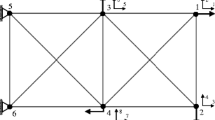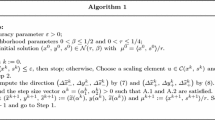Abstract
In this paper we analyze from a unique point of view the behavior of path-following and primal-dual potential reduction methods on nonlinear conic problems. We demonstrate that most interior-point methods with\(O(\sqrt n ln(1/ \in ))\) efficiency estimate can be considered as different strategies of minimizing aconvex primal-dual potential function in an extended primal-dual space. Their efficiency estimate is a direct consequence of large local norm of the gradient of the potential function along a central path. It is shown that the neighborhood of this path is a region of the fastest decrease of the potential. Therefore the long-step path-following methods are, in a sense, the best potential-reduction strategies. We present three examples of such long-step strategies. We prove also an efficiency estimate for a pure primal-dual potential reduction method, which can be considered as an implementation of apenalty strategy based on a functional proximity measure. Using the convex primal dual potential, we prove efficiency estimates for Karmarkar-type and Dikin-type methods as applied to a homogeneous reformulation of the initial primal-dual problem.
Similar content being viewed by others
References
D.A. Bayer and J.C. Lagarias, “The nonlinear geometry of linear programming. I: Affine and projective scaling trajectories. II: Legendre transform coordinates and central trajectories,”Transactions of the American Mathematical Society 314 (1989) 499–581.
G. de Ghellink and J.-P. Vial, “A polynomial Newton method for linear programming,”Algorithmica 1 (1986) 425–453.
I.I. Dikin, “Iterative solution of problems of linear and quadratic programming,”Soviet Mathematics, Doklady 8 (1967) 674–675.
C.C. Gonzaga, “An algorithm for solving linear programming problems in O(n 3 L) operations,” in: N. Meggido, ed.,Progress in Mathematical Programming: Interior Point and Related Methods (Springer-Verlag, Berlin, 1989) pp. 1–28.
C.C. Gonzaga and R.A. Tapia, “On the quadratic convergence of the simplified Mizuno-Todd-Ye algorithm for Linear Programming,” Research Report TR92-42, Rice University, Houston, TX 77 251 (1992).
B. Jansen, C. Roos, T. Terlaky and J.-P. Vial, “Interior-point methodology for Linear Programming: Duality, sensitivity analysis and computational aspects.” Technical Report No. 1993.12, Geneva University (1993).
N. Karmarkar, “A new polynomial-time algorithm for linear programming,”Combinatorica 4 (1984) 373–395.
M. Kojima, N. Meggido, T. Noma and Y. Yoshise, “A unified approach to interior point algorithms for linear complementarity problems,”Lecture Notes in Computer Science, Vol. 538 (Springer-Verlag, New York, 1991).
S. Mizuno, M.J. Todd and Y. Ye, “On adaptive step primal-dual interior-point algorithms for linear programming,”Mathematics of Operations Research 18 (1993) 964–981.
Yu. Nesterov and A. Nemirovsky,Interior Point Polynomial Algorithms in Convex Programming (SIAM, Philadelphia, PA, 1994).
Yu. Nesterov, “Complexity estimates of some cutting plane methods based on analytical barrier,”Mathematical Programming 69 (1995) 149–176.
J. Renegar, “A polynomial time algorithm, based on Newton’s method, for linear programming,”Mathematical Programming 40 (1988) 59–93.
K. Tanabe, “Centered Newton method for mathematical programming,” in: M. Iri and K. Yajima, eds.,System Modeling and Optimization: Proceedings of the 13th IFIP Conference. Tokyo, Japan, Aug./Sept. 1987, Vol. 113 ofLecture Notes in Control and Information Sciences (Springer-Verlag, Berlin, 1988) pp. 197–206.
M.J. Todd and Y. Ye, “A centered projective algorithm for linear programming,”Mathematics of Operations Research 15 (1990) 508–529.
P.M. Vaidya, “An algorithm for linear programming which requires O(((m + n)n 2 + (m + n)1,5 n)L) arithmetic operations,”Mathematical Programming 47 (1990) 175–202.
Y. Ye, “An O(n 3 L) potential reduction algorithm for linear programming,”Mathematical Programming 50 (1991) 239–258.
Author information
Authors and Affiliations
Rights and permissions
About this article
Cite this article
Nesterov, Y. Long-step strategies in interior-point primal-dual methods. Mathematical Programming 76, 47–94 (1997). https://doi.org/10.1007/BF02614378
Received:
Revised:
Issue Date:
DOI: https://doi.org/10.1007/BF02614378




